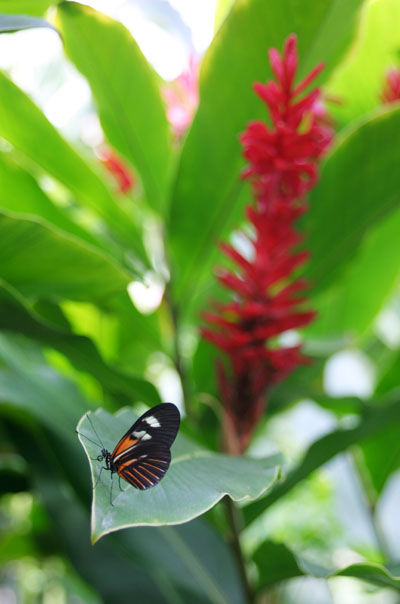 We just broke a run of over two weeks of temperatures exceeding 100 degrees F during the day here, so of course, now I’ll bring you a tip about shooting in hot weather.
We just broke a run of over two weeks of temperatures exceeding 100 degrees F during the day here, so of course, now I’ll bring you a tip about shooting in hot weather.
Don’t do it. Seriously, just stay indoors.
Okay, if you’re dedicated or stupid, I suppose I can give something more useful. I’ve run into this problem quite a few times now, from shooting in Florida, butterfly houses and rainforest exhibits, and now for a couple of weeks in abnormal conditions for North Carolina. Your camera, of course, should be kept cool – film doesn’t handle heat well, and starts to decay towards color-shifting, but much worse, your lenses can be really messed up with heat. Many have a lubricant inside to keep the zoom and/or focus rings operating smoothly, and this can get a lot thinner as it gets hot. This can make it run onto the lens surfaces themselves, but much worse, onto the aperture blades. These are very light thin pieces of metal that have to snap open and closed very quickly, and getting gummed up with any kind of moisture, even when it’s supposed to be a lubricant, can cause your aperture to become erratic or stuck fast. That’s called a minimum $100 lens repair.
But keeping the camera cool, such as remaining in air-conditioning, leads to a problem when you take it out in hot, humid conditions – it acts like a nice cold glass of lemonade, especially the glass. The lens glass, and sometimes even the camera body, will attract condensation and fog up. Your best bet is to leave the camera in the bag out of contact with the humid air until it warms up closer to ambient temperature, but if you have a properly padded and closed bag, this acts like insulation, so warming up can take a while. Whatever you do, however, don’t uncap your lens, and most especially don’t switch lenses, which lets moist air into the insides of the lens and can cause fogging on interior elements. I did this once and it takes forever to clear. Bright sunlight can help bring the camera and lens up in temperature faster, and a faint breeze helps too.
Don’t try to rush things, but instead try to plan your shooting around such conditions. This doesn’t always work – several times these past two weeks I found a photo subject and fetched the camera, only to have to wait until it could be used. Don’t count on microfiber lens cleaning cloths to dry off the surfaces, either – they’re usually not very absorbent and only distribute humidity around in droplets. A small towel in your camerabag can help dry off the body, if you need it (and you should have one in case of wet weather and splashing water,) but don’t use it on your lens, because they’re bad about retaining grit and using that to scratch the glass. Patience can save you a few hundred dollars in replacing a favorite lens.
The other issue I encounter frequently is viewfinder fogging. This is made much worse because I wear glasses, so the extra glass surface cuts air circulation right around the eyepiece, and contributes to heat buildup. So does a hat brim, and while I recommend a good shady hat for outdoor shooting, they can contribute to fogging in rough conditions. I have yet to try those pith helmets with a fan built into the brim (I don’t mind looking a little goofy, but there’s a limit,) though this strikes me as probably an effective solution. Battery-powered little fans can be found in most department stores, but this leads to the problem of how to hold it and the camera, and adjust the lens at the same time. A simple sweatband, believe it or not, has proven most effective, if only because it absorbs some of the humidity from your own sweat that would be present near your eye.
Finally, a little tip to keep your camera looking good. With hot weather comes insect repellent, which is fine and often necessary. Just be aware that anything containing DEET will eat into the plastic of your camera body, lenses, binoculars, and so on. Even wiping your repellent-treated forehead and grabbing the camera can mark it. Keep that towel handy.



















































